The bright colours of this granular poison frog signal a warning to predators of its toxicity.
The honey badger's reverse countershading makes it conspicuous, warning of its aggressive temperament, and its sharp teeth and claws
Aposematism is exploited in Müllerian mimicry, where species with strong defences evolve to resemble one another. By mimicking similarly coloured species, the warning signal to predators is shared, causing them to learn more quickly at less of a cost to each of the species.
Warning signals do not necessarily require that a species actually possesses chemical or physical defences to deter predators. Mimics such as the nonvenomous California mountain kingsnake (Lampropeltis zonata), which has yellow, red, and black bands similar to those of the highly venomous eastern coral snake (Micrurus fulvius), have essentially piggybacked on the successful aposematism of the model. The evolution of a warning signal by a mimicking species that resembles a species that possesses strong defences is known as Batesian mimicry.
Contents
Etymology
The term Aposematism was coined by the English zoologist Edward Bagnall Poulton in his 1890 book The Colours of Animals. He based the term on the Ancient Greek words ἀπό apo away, ση̑μα sēma sign, referring to signs that warn other animals away.[1][2]Defence mechanism
Flamboyant cuttlefish colours warn of toxicity
Further information: signalling theory
The function of aposematism is to prevent attack, by warning
potential predators that the prey animal has defences such as being
unpalatable or poisonous. The easily detected warning is a primary
defence mechanism, and the non-visible defences are secondary.[6] Aposematic signals are primarily visual, using bright colours and high-contrast patterns such as stripes. Warning signals are honest indications of noxious prey, because conspicuousness evolves in tandem with noxiousness.[7] Thus, the brighter and more conspicuous the organism, the more toxic it usually is.[7][8]The most common and effective colours are red, yellow, black and white.[9] These colours provide strong contrast with green foliage, resist changes in shadow and lighting, have strong contrast, are highly chromatic, and provide distance dependent camouflage.[9] Some forms of warning colouration provide this distance dependent camouflage by having an effective pattern and colour combination that do not allow for easy detection by a predator from a distance, but are warning-like from a close proximity, allowing for an advantageous balance between camouflage and aposematism.[10] Warning colouration evolves in response to background, light conditions, and predator vision.[11] Visible signals may be accompanied by odours, sounds or behaviour to provide a multi-modal signal which is more effectively detected by predators.[12]
Hycleus lugens, an aposematically coloured beetle
Prevalence
The skunk, an aposematic mammal
In terrestrial ecosystems
Aposematism is widespread in insects, but less so in vertebrates, being mostly confined to a smaller number of reptile, amphibian, and fish species. Perhaps the most numerous aposematic vertebrates are the poison dart frogs.[17] Some plants are thought to employ aposematism to warn herbivores of unpalatable chemicals or physical defences such as prickled leaves or thorns.[18] Many insects, such as cinnabar moth caterpillars, acquire toxic chemicals from their host plants.[19] Among mammals, skunks and zorillas advertise their foul-smelling chemical defences with sharply contrasting black-and-white patterns on their fur.[20] Some brightly coloured birds such as passerines with contrasting patterns may also be aposematic, at least in females; but since male birds are often brightly coloured through sexual selection, and their colouration is not correlated with edibility, it is unclear whether aposematism is significant.[21]
There is evidence that nudibranchs like Phyllidia varicosa are aposematic.
In marine ecosystems
Nudibranch molluscs are the most commonly cited examples of aposematism in marine ecosystems, but the evidence for this has been contested,[26] mostly because (1) there are few examples of mimicry among species, (2) many species are nocturnal or cryptic, and (3) bright colours at the red end of the colour spectrum are rapidly attenuated as a function of water depth. For example, the Spanish Dancer nudibranch (genus Hexabranchus), among the largest of tropical marine slugs, potently chemically defended, and brilliantly red and white, is nocturnal and has no known mimics. Mimicry is to be expected as Batesian mimics with weak defences can gain a measure of protection from their resemblance to aposematic species.[27] Other studies have concluded that nudibranchs such as the slugs of the family Phyllidiidae from Indo-Pacific coral reefs are aposematically coloured.[28] Müllerian mimicry has been implicated in the colouration of some Mediterranean nudibranchs, all of which derive defensive chemicals from their sponge diet.[29]
The crown-of-thorns starfish, like other starfish such as Metrodira subulata, has conspicuous coloration and conspicuous long, sharp spines, as well as chemical defences in the form of saponins; this evidence is argued to be sufficient for such species to be considered aposematic.[22][23] It has been proposed that aposematism and mimicry is less evident in marine invertebrates than terrestrial insects because predation is a more intense selective force for many insects, which also disperse as adults rather than as larvae and have much shorter generation times.[24] Further, there is evidence that fish predators such as blueheads may adapt to visual cues more rapidly than do birds, making aposematism less effective.[30]
Iridescent blue rings on the mantles of the venomous Hapalochlaena lunulata are considered by some to be an aposematic warning
Behaviour
The defence mechanism relies on the memory of the would-be predator; a bird that has once experienced a foul-tasting grasshopper will endeavour to avoid a repetition of the experience. As a consequence, aposematic species are often gregarious. Before the memory of a bad experience attenuates, the predator may have the experience reinforced through repetition. Aposematic organisms often move in a languid fashion, as they have little need for speed and agility. Instead, their morphology is frequently tough and resistant to injury, thereby allowing them to escape once the predator is warned off. Aposematic species do not need to hide or stay still as cryptic organisms do, so aposematic individuals benefit from more freedom in exposed areas and can spend more time foraging, allowing them to find more and better quality food.[37] Aposematic individuals can similarly make use of conspicuous mating displays.[38]Origins of the theory
Gregarious nymphs of an aposematic milkweed bug, Lygaeus kalmii
Wallace, 1867
In a letter to Alfred Russel Wallace dated 23 February 1867 Charles Darwin wrote "On Monday evening I called on Bates & put a difficulty before him, which he could not answer, & as on some former similar occasion, his first suggestion was, 'you had better ask Wallace'. My difficulty is, why are caterpillars sometimes so beautifully & artistically coloured?"[39] Darwin was puzzled because his theory of sexual selection (where females choose their mates based on how attractive they are) could not apply to caterpillars since they are immature and hence not sexually active.Wallace replied the next day with the suggestion that since some caterpillars "...are protected by a disagreeable taste or odour, it would be a positive advantage to them never to be mistaken for any of the palatable catterpillars [sic], because a slight wound such as would be caused by a peck of a bird’s bill almost always I believe kills a growing catterpillar [sic]. Any gaudy & conspicuous colour therefore, that would plainly distinguish them from the brown & green eatable catterpillars [sic], would enable birds to recognise them easily as
Since Darwin was enthusiastic about the idea, Wallace asked the Entomological Society of London to test the hypothesis.[41] In response, the entomologist John Jenner Weir conducted experiments with caterpillars and birds in his aviary, and in 1869 he provided the first experimental evidence for warning colouration in animals.[42]
Poulton, 1890
Wallace coined the term "warning colours" in an article about animal coloration in 1877.[3] In 1890 Edward Bagnall Poulton renamed the concept aposematism in his book The Colours of Animals[2] He described the derivation of the term as follows:The second head (Sematic Colours) includes Warning Colours and Recognition Markings: the former warn an enemy off, and are therefore called Aposematic [Greek, apo, from, and sema, sign][43]
Evolution
Aposematism is paradoxical in evolutionary terms, as it makes individuals conspicuous to predators, so they may be killed and the trait eliminated before predators learn to avoid it. If warning colouration puts the first few individuals at such a strong disadvantage, it would never last in the species long enough to become beneficial.[44]Supported explanations
There is evidence for explanations involving dietary conservatism, in which predators avoid new prey because it is an unknown quantity;[45] this is a long-lasting effect.[45][46][47] Dietary conservatism has been demonstrated experimentally in some species of birds.[45][47] Further, birds recall and avoid objects that are both conspicuous and foul-tasting longer than objects that are equally foul-tasting but cryptically coloured. This suggests that Wallace's original view, that warning colouration helped to teach predators to avoid prey thus coloured, was correct.[48] However, some birds (inexperienced starlings and domestic chicks) also innately avoid conspicuously coloured objects, as demonstrated using mealworms painted yellow and black to resemble wasps, with dull green controls. This implies that warning colouration works at least in part by stimulating the evolution of predators to encode the meaning of the warning signal, rather than by requiring each new generation to learn the signal's meaning.[48] All of these results contradict the idea that novel, brightly coloured individuals would be more likely to be eaten or attacked by predators.[45]Alternative hypotheses
Other explanations are possible. Predators might innately fear unfamiliar forms (neophobia)[49] long enough for them to become established, but this is likely to be only temporary.[44][49][50]Alternatively, prey animals might be sufficiently gregarious to form clusters tight enough to enhance the warning signal. If the species was already unpalatable, predators might learn to avoid the cluster, protecting gregarious individuals with the new aposematic trait.[51][52] Gregariousness would assist predators to learn to avoid unpalatable, gregarious prey.[53] Aposematism could also be favoured in dense populations even if these are not gregarious.[45][49]
Another possibility is that a gene for aposematism might be recessive and located on the X chromosome.[54] If so, predators would learn to associate the colour with unpalatability from males with the trait, while heterozygous females carry the trait until it becomes common and predators understand the signal.[54] Well-fed predators might also ignore aposematic morphs, preferring other prey species.[44][55]
A further explanation is that females might prefer brighter males, so sexual selection could result in aposematic males having higher reproductive success than non-aposematic males if they can survive long enough to mate. Sexual selection is strong enough to allow seemingly maladaptive traits to persist despite other factors working against the trait.[17]
Once aposematic individuals reach a certain threshold population, for whatever reason, the predator learning process would be spread out over a larger number of individuals and therefore is less likely to wipe out the trait for warning colouration completely.[56] If the population of aposematic individuals all originated from the same few individuals, the predator learning process would result in a stronger warning signal for surviving kin, resulting in higher inclusive fitness for the dead or injured individuals through kin selection.[57]
A newer theory for the evolution of aposematism posits that it arises by reciprocal selection between predators and prey, where distinctive features in prey are selected by non-discriminating predators, and where, concurrently, avoidance of distinctive prey is selected by predators. Concurrent reciprocal selection (CRS) may entail learning by predators or it may give rise to unlearned avoidances by them. Aposematism arising by CRS operates without special conditions of the gregariousness or the degrees of related of prey, and it is not contingent upon predator sampling of prey to learn that aposematic cues are associated with unpalatability or other unprofitable features.[citation needed]
Mimicry
A venomous and genuinely aposematic coral snake
The harmless red milk snake, a Batesian mimic of the coral snake
Further information: Mimicry
Aposematism is a sufficiently successful strategy to have had
significant effects on the evolution of both aposematic and
non-aposematic species.Non-aposematic species have often evolved to mimic the conspicuous markings of their aposematic counterparts. For example, the hornet moth is a mimic of the yellowjacket wasp; it resembles the wasp, but has no sting. A predator which avoids the wasp will to some degree also avoid the moth. This is known as Batesian mimicry, after Henry Walter Bates, a British naturalist who studied Amazonian butterflies in the second half of the 19th century.[58] Batesian mimicry is frequency dependent: it is most effective when the ratio of mimic to model is low; otherwise, predators learn to recognise the impostors.[59][60]
A second form of mimicry occurs when two aposematic organisms share the same anti-predator adaptation and mimic each other, to the benefit of both species, since fewer individuals of either species need to be attacked for predators to learn to avoid both of them. This form of mimicry is known as Müllerian mimicry, after Fritz Müller, a German naturalist who studied the phenomenon in the Amazon in the late 19th century.[61][62] Many species of bee and wasp that occur together are Müllerian mimics; their similar colouration teaches predators that a striped pattern is associated with being stung. Therefore, a predator which has had a negative experience with any such species will likely avoid any that resemble it in the future. Müllerian mimicry is found in vertebrates such as the mimic poison frog (Ranitomeya imitator) which has several morphs throughout its natural geographical range, each of which looks very similar to a different species of poison frog which lives in that area.[63]
See also
Notes
- Other advertising signals include the bright colours of flowers which lure pollinators.
References
- Twomey, Evan; Brown, Jason (1986). "Ranitomeya imitator". Dendrobates.org. Retrieved 11 May 2015.
Sources
- Capinera, John L., ed. (2008). Encyclopedia of Entomology(2nd ed.). Springer. ISBN 978-1-4020-6242-1.
- Edmunds, M. (1974). Defence in Animals. Longman. ISBN 0-582-44132-3.
- Poulton, Edward Bagnall (1890). The Colours of Animals, their meaning and use, especially considered in the case of insects. London: Kegan Paul, Trench & Trübner.
- Ruxton, G. D.; Speed, M. P.; Sherratt, T. N. (2004). Avoiding Attack. The Evolutionary Ecology of Crypsis, Warning Signals and Mimicry. Oxford University Press. ISBN 0-19-852860-4
External links
| Wikimedia Commons has media related to Warning coloration. |
defensive animal spines are often conspicuous (shape and colour) and should be considered aposematic... Classic examples are the starfishes Acanthaster planci and Metrodira subulata, which have red spines...
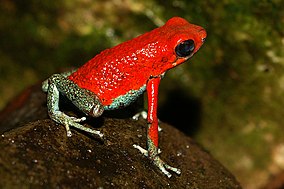
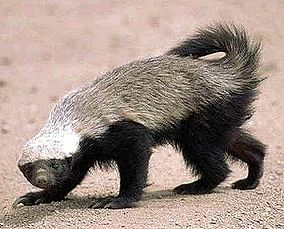
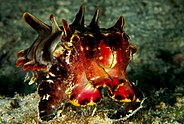



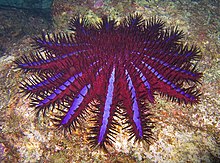

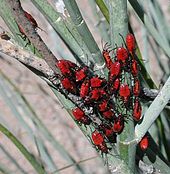

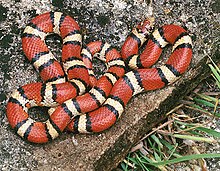
Keine Kommentare:
Kommentar veröffentlichen